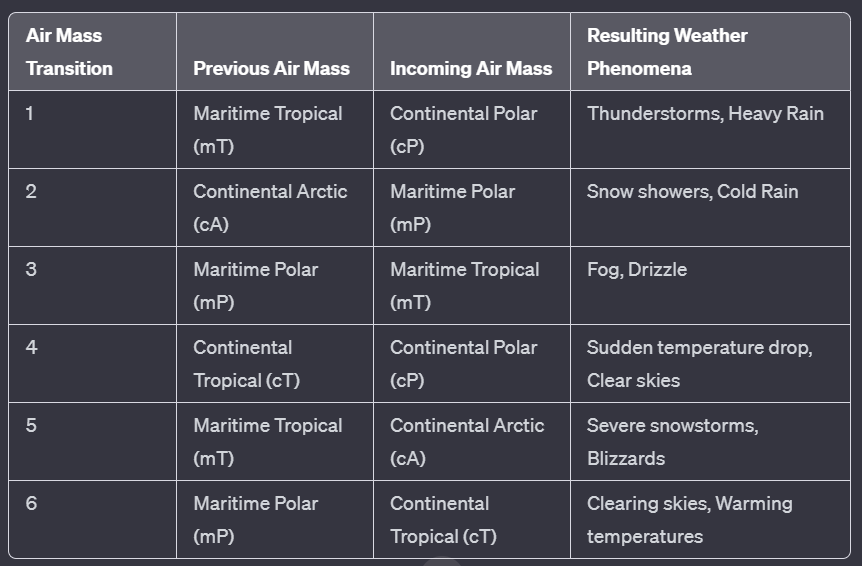Introduction: Fronts are the battlegrounds where different air masses clash. Recall our discussion about air masses from Christmas Eve can be classified differently. As different air masses meet, it can lead to changes in weather conditions. In Part 9 of our weather education series, we’ll explore fronts and the weather systems they create, helping you understand how these dynamic interactions influence the weather we experience.
Understanding Fronts: Fronts are boundaries that separate air masses with different temperature, humidity, and density characteristics. We call them fronts because they are the literal front of a airmass. These fronts play a critical role in meteorology and are responsible for various weather conditions. Often when we change from one airmass to another, we can anticipate different types of weather. Generally there are six different types of airmass transitions:

Types of Fronts: There are four main types of fronts, each with its distinctive characteristics:
- Cold Front: A cold front occurs when a fast-moving, cold air mass advances and replaces a warmer air mass. As the cold air pushes the warm air upward, it cools and condenses, leading to the formation of clouds and potentially severe weather, including thunderstorms.
- Warm Front: A warm front occurs when a warm air mass overtakes a slower-moving, colder air mass. The warm air rises over the cold air, creating a gentle slope. This results in gradual temperature increases and often brings steady precipitation and overcast skies.
- Stationary Front: A stationary front forms when two air masses with different temperature and humidity characteristics meet but neither displaces the other. This can lead to prolonged periods of rain, drizzle, or other weather conditions, depending on the air masses involved.
- Occluded Front: An occluded front occurs when a fast-moving cold front overtakes a warm front, lifting the warm air mass above the cold air mass. This can create complex weather systems with a mix of precipitation and changing conditions.
Weather Associated with Fronts: Fronts play a central role in the development of weather systems. When a front passes through an area, it can trigger various weather phenomena, including:
- Thunderstorms: Cold fronts are often associated with the development of thunderstorms, which can bring heavy rain, lightning, and strong winds.
- Rain: Warm fronts and stationary fronts frequently lead to steady, prolonged periods of rain or drizzle.
- Temperature Changes: Fronts can bring rapid temperature changes. Cold fronts lead to temperature drops, while warm fronts result in milder conditions.
- Cloud Formation: Fronts can trigger cloud formation and affect cloud types, leading to overcast skies or the appearance of specific cloud patterns.
Front Movements: Fronts can be either cold or warm, and they move in different ways. Cold fronts tend to move faster and have a steeper slope, leading to more abrupt weather changes. Warm fronts move more slowly and have a shallower slope, resulting in gradual weather transitions.
Highs and Lows: Additionally, it’s crucial to understand the role of high-pressure systems and low-pressure systems in weather. High-pressure systems are characterized by descending air masses, resulting in stable atmospheric conditions. They often bring clear skies, light winds, and pleasant weather.
In contrast, low-pressure systems involve rising air masses, leading to instability and the potential for precipitation, storms, and unsettled weather patterns. These pressure systems, in conjunction with fronts, play a fundamental role in shaping the complex and ever-changing world of meteorology.
Take Home: Fronts are fundamental in understanding weather patterns and forecasting. They mark the boundaries where air masses interact, leading to shifts in temperature, humidity, and atmospheric conditions. By recognizing the types of fronts and their associated weather systems, meteorologists can provide us with valuable insights into future weather conditions.
In our final post of this series, we’ll explore the fascinating world of weather forecasting, including the tools and techniques meteorologists use to predict the weather. If you have any questions or topics you’d like us to cover, please feel free to reach out. Stay curious, and stay tuned for more weather insights!

